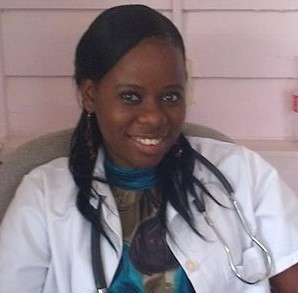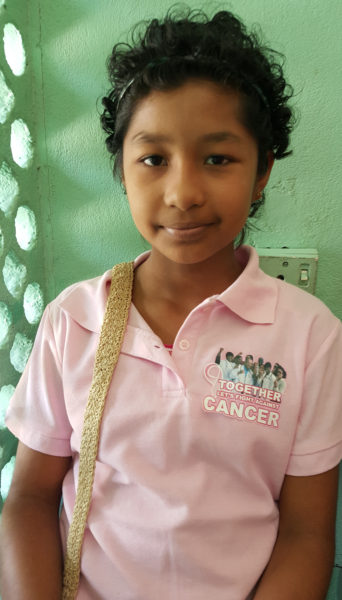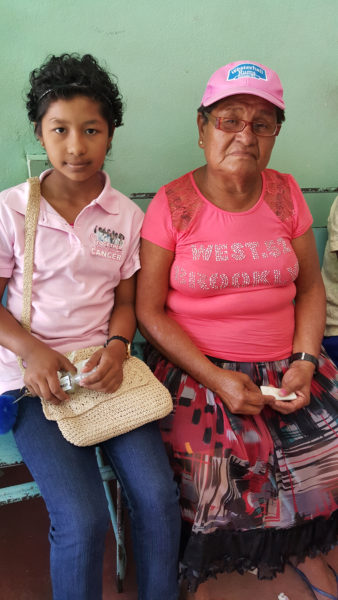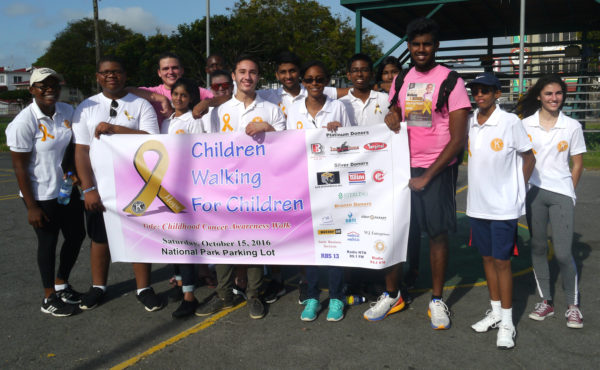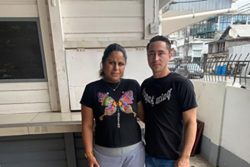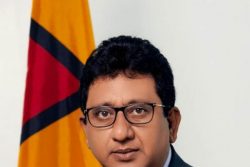Sporting a pink t-shirt, with the words “Together let’s fight against cancer,” 12-year-old Shelly Debideen could be found busily assisting the volunteers at a cancer outreach at Kuru Kururu, on the Linden-Soesdyke Highway last month.
Shelly, who was diagnosed two years ago with ovarian cancer, is a cancer survivor. During the outreach, as a group of adults waited to be screened, she shared her experience battling the disease and coping with chemotherapy.
The activity, though organised to mark Breast Cancer Awareness Month, also saw screenings done for other types of cancers, including prostate and cervical cancer. It was the result of a collaboration between the Oncology Department of the Georgetown Public Hospital (GPHC), the Ministry of Public Health and the Cancer Institute of Guyana (CIG) and was intended to give the residents an opportunity to know their status and seek early treatment if required.
The outreach was deemed a success after four “suspected” positive cases were identified.
GPHC Oncologist Dr. Latoya Gooding said making the initial diagnosis “is a plus” as the organisers are trying to promote early detection, which can mean the difference between life and death.
Yet, while cancer awareness activities often advocate screenings, their intended target audience are not usually children. Shelly’s case is rare—she was the first such case diagnosed in Guyana—but cancer in children is not. Among the children living with cancers in Guyana, leukemia is the most common diagnosis.
In fact, according to the Pan American Health Organization/World Health Organization (PAHO/WHO), cancer is among the leading causes of death in children over one in many countries of the Americas and acute lymphoblastic leukemia is the most common type.
Too young to have cancer
Just a few child cancer patients are hospitalised at the GPHC, while some have been discharged but continue to get treatment as outpatients.
However, there is a high mortality rate among children with cancer. Their cause of death is not the cancer itself but the infections they contract during hospitalisation or during remission, when their immune systems are deficient and they are especially vulnerable.
As a result, Dr. Gooding said the child cancer patients are placed in an isolation room at the GPHC but it can only accommodate four patients at a time.
When the children become “clinically stable,” she added, they are placed in a semi-isolation room and not in the general wards.
Although visitors are required to wear facemasks and gloves, Dr. Gooding said the children are still vulnerable to contracting infections. As a result, the hospital is now trying to enforce stricter measures that would require visitors to wear gowns and caps as well.
Although the patients are exposed to infections when they are discharged from the hospital, by that point their immune systems are usually capable of handling them.
Dr. Gooding has already made a recommendation for another isolation room and the hospital is moving the semi-isolation room to another one nearby that they would be able to enclose.
That was necessary because “we find that too many children are dying… Many people believe that children are too young to have cancer and so they tend to ignore certain symptoms,” Dr. Gooding said.
Ovarian cancer is known mainly to affect adult women, so two years ago, when Shelly, then 10, complained of severe abdominal pain, no one expected her to be diagnosed with the disease.
In fact, when her mother took her to the hospital in her area, the doctor gave her painkillers and sent her home. “The doctor said that the pain was from running and jumping and I would be ok,” Shelly related.
At the time she was living with her mother and four younger siblings at Port Kaituma, in the North West District, far away from where testing for any type of cancer is conducted.
She continued taking the pills but the pain would ease for a while and then return. Three weeks after her first visit to the doctor, the pain became unbearable. It was then that her mother noticed a swelling, which turned out to be a malignant tumour, on her right side and rushed her back to the hospital.
This time she was seen by a different doctor, who felt the lump and immediately transferred her to the GPHC for tests to be conducted. Shelly’s mother had no one to care for her younger siblings so the girl travelled alone to the Ogle Airport, where a nurse received her in an ambulance.
Her grandmother, Celestine De Freitas and an aunt of Kuru Kururu, Linden Highway later visited her at the GPH, where she spent the next few hours undergoing ultrasounds and other tests. When the doctors got the results, they prepared her for emergency surgery the following morning.
Her grandmother and aunt, as well as her mother were devastated when they learned of her diagnosis.
Shelly recalled that before the surgery “the doctor put a mask over my face and I went to sleep… The pain and the swelling were gone after that. I had to be in bed for the first three days and I spent three weeks in the hospital.”
She started living with her grandparents at Kuru Kururu after she was discharged from the hospital.
Shelly was too young to understand the meaning of cancer and the changes it would have on her body. And she was definitely not prepared for the effects of chemotherapy, especially losing her hair. Shelly cried bitterly when clumps of her hair fell out as she was combing it one day.
Her grandmother, Celestine, comforted her and gave her the assurance that her hair would grow back even thicker and longer. To make the situation less traumatic, her grandparents cut her hair very short and so as it continued to fall out, she was not as worried.
But after she became completely bald, Shelly said she did not want to go out and play because she was afraid that the other children would make fun of her. Her aunt then decided to wrap her head with scarves, which helped and later she wore a wig that helped her fit in at her new school.
Awareness
Like Shelly, most of the child cancer patients are from interior locations, which makes it difficult for them to travel to Georgetown in time to undergo tests and treatment. “This is mostly due to financial difficulties and geographically it is too far,” Dr. Gooding noted.
Indeed, with the release of a new manual, Early Diagnosis of Childhood Cancer, last year, PAHO/WHO noted that cancer survival rates are 10% to 20% lower in lower-income countries than in higher-income countries due to, among other things, late diagnosis, limited access to treatment, and disease recurrence.
The PAHO/WHO manual is intended to guide health care providers in identifying suspicious signs and symptoms. “The vast majority of diagnostic errors are due to the lack of a thorough interview, clinical history review, and physical examination, as well as to the common mistake of ignoring some symptom that the parents report, or not giving it the importance it deserves,” it states.
Apart from delays in diagnoses, Dr. Gooding said there may be other risk factors in interior areas, like the drinking water being contaminated with the mercury from the mining operations. As a result, she plans to conduct research through an organisation she has founded, the Giving Hope Foundation (GHF), to determine if there is a direct relation to the cancer.
She advised parents to check their children to ensure any ailments can be addressed early. Among the children who died this year was a four-year-old, who was diagnosed with testicular cancer or seminoma.
Due to the lack of knowledge about cancer in children, the GHF, in collaboration with the Georgetown International Academy’s (GIA) Key Club, organised a walk on October 15 to raise awareness.
“That [walk] opened the eyes for some people because they did not know children can get cancer… For persons to come and tell me that they did not know until the walk, I think we are accomplishing our aim,” she said.
Childhood Cancer Awareness month is observed yearly in September but no local activity was organised to mark it.
Four children with cancer were among 300 persons who participated in the walk, which was held under the theme “Children walking for children–help us fight cancer now.”
President of the Key Club Gabriel Beharry-Strand proudly told Stabroek News that they have raised $11.3M, which was donated to the GHF.
The walk ended at Parade Ground, where Faculty Advisor of GIA Joanna Trim gave brief remarks along with Beharry-Strand and Minister of Social Protection, Volda Lawrence who led the walk.
The short ceremony after the march commenced with a moment of silence in observance of patients who succumbed to cancer this year.
Trim told Stabroek News that the walk was held in aid of children in Guyana who are battling various forms of cancer, especially those from hinterland regions and those who are in need of assistance for cancer treatment.
“It’s honestly surreal that the walk took place… It was a huge success!” said Beharry-Strand, who explained that the event was close to his heart because he lost his grandparents to leukemia recently.
“I couldn’t imagine children going through the pain they did,” he said. “I decided to do this walk because mourning over their passing wasn’t what I should do, I should turn something that is so hard for me into a positive.”
According to him, the Key Club, which is made up of other students of GIA, is about service. “…We have the chance to not only share that service, but to help make a difference that matters. The time, energy and resources we invest today will pay off in dividends for our communities, their children and their futures,” he added.
Giving hope
Meanwhile, Dr. Gooding said her organisation, which is made up of childhood patient volunteers, was formed almost two months ago.
She noted that she changed the name of the foundation about five times until she finally settled on its present name. Afterward, she found out that there is an international organisation with the same name that deals with childhood cancers as well. “We have decided to form an alliance with them because we are not going to change our name. We wanted a name to show that we are giving hope… We want to give hope to patients,” she explained.
The idea is to make “childhood cancer [and cancer as a whole] a daily topic to ensure that children get the effective treatment that they need. Whether it is locally or overseas, we would be the advocates for those children,” she added.
The local organisation provides financial help to offset medical expenses, especially for leukemia patients, along with moral support for the children and their families. As a result, the walk, Dr. Gooding noted, was not just to raise awareness, but funds as well.
Dr. Gooding was grateful for the donation from the Key Club and said it is a good start but given the nature of the disease, a lot more money has to be raised.
Some of the leukemia patients may require bone marrow transplants, which in addition to being very costly are not done in Guyana. It is one of the reasons that the chances of survival, especially among children, are very slim. However, if the cancers are detected and treated early, the doctors may be able to save a life, like in the case of Shelly.
Shelly underwent treatment, including six chemotherapy and physiotherapy sessions, for one year.
Losing a lot of weight and hardly having any energy to be her normal, vibrant self, Shelly spent most of days in bed. By then she started worrying and asking her grandmother if she would survive at one point.
However, her grandparents proved to be her biggest strengths as they saw her through her struggles with patience and perseverance.
Celestine said that she stayed all day at the hospital with Shelly. “I did everything in my power to see her through her suffering. Dr. Gooding and the other doctors were always there for her and I’m so grateful to them,” she added, while also thanking a family in Georgetown that provided financial help to her as well.
She recalled that she was struggling financially but never wanted Shelly to find out but said somehow she did.
“When she was discharged from hospital she needed special items and she would tell me not to bother buy them… but I tell her as long as you need it you have to get it,” Celestine said. “She’s a part of me. Sometimes I worry if anything wrong with me, who would take care of her?”
Shelly’s recovery was progressing well until about one year ago when she started experiencing pain again in the same area, but less severe. She was readmitted to the hospital for a few days.
After that she did not experience any more problems. She said she was “thankful to the nice and caring doctors and everyone who helped me. And I thank God for blessing me with such wonderful grandparents.”
